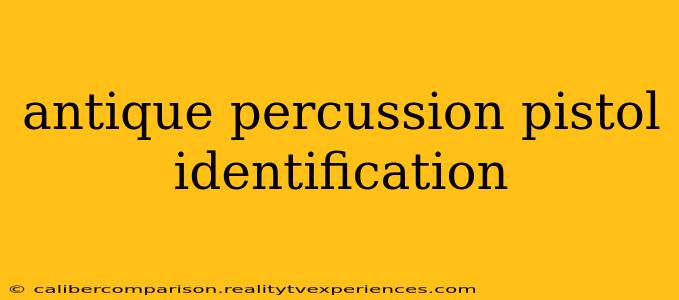Identifying antique percussion pistols can be a fascinating and rewarding pursuit, bridging history, craftsmanship, and collecting. However, it requires careful examination and a methodical approach. This guide provides a comprehensive overview of the key features to consider when identifying your antique percussion pistol. Remember, always handle antique firearms safely and responsibly. Consult with a qualified firearms expert if you have any doubts about the safety or identification process.
Understanding Percussion Pistols
Before diving into identification, understanding the mechanics of percussion pistols is crucial. These pistols, popular from the early 19th century to the mid-1800s, utilize a percussion cap containing a highly sensitive explosive compound. The cap is struck by the hammer, igniting the powder charge and firing the projectile. This system replaced the less reliable flintlock mechanism.
Key Features for Identification
Several key features help pinpoint the maker, age, and origin of your antique percussion pistol. These include:
1. The Barrel:
- Material: Most barrels were made of steel, but some might be found in other metals like iron or even bronze. Examine the barrel for markings indicating the maker or its origin.
- Length & Caliber: Measure the barrel length (from breech to muzzle) and determine the caliber (the diameter of the bore). These measurements are crucial for identification.
- Rifling: Check for rifling (the spiral grooves inside the barrel). Rifled barrels improve accuracy. Note the number of grooves and their twist rate.
2. The Lockplate:
- Markings: The lockplate is often engraved with the maker's name, city of origin, or other identifying marks. These markings are vital for identification and determining the pistol's provenance. Carefully examine the markings, taking high-quality photographs for comparison with known maker's marks.
- Design & Style: Lockplate designs varied significantly across makers and time periods. Studying lockplate styles can help narrow down the potential manufacturers. Some styles were common to particular regions or time periods.
- Construction: Note the material (usually steel) and method of construction. Details such as the hammer shape and the location of the nipple can provide valuable clues.
3. The Frame:
- Material: The frame, the structure encompassing the lock and barrel, could be made from various materials including steel, brass, or wood. The material influences the pistol's overall weight and feel.
- Construction: Observe how the frame is constructed, noting any distinctive design features. Some were made in one piece, while others utilized multiple components.
4. The Grips:
- Material: Grips were often made from wood (walnut was common), but some examples feature bone, horn, or even ivory.
- Style & Shape: The style and shape of the grips can provide clues about the pistol's origin and period.
5. Other Identifying Features:
- Ramrod: Examine the ramrod (used to load the powder and ball) for any markings. Some pistols had ramrods integrated into the frame.
- Trigger Guard: The trigger guard's shape and style can offer valuable clues.
- Overall Condition: The overall condition of the pistol, including any signs of wear, damage, or repair, can indicate its age and history.
Resources for Identification:
Several resources can assist in identifying your antique percussion pistol:
- Books & Publications: Numerous books and specialized publications are dedicated to antique firearms.
- Online Forums & Communities: Engage with online communities of firearms enthusiasts and collectors for expert advice and information sharing.
- Museums & Historical Societies: Museums with firearms collections are valuable sources of information and expertise.
Conclusion:
Identifying an antique percussion pistol demands careful observation and attention to detail. By systematically examining the barrel, lockplate, frame, grips, and other components, and by consulting relevant resources, you can significantly increase the likelihood of successfully identifying your antique firearm and uncovering its rich history. Remember, safety is paramount. Handle antique firearms with care and always prioritize responsible ownership.

